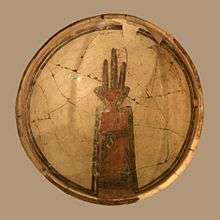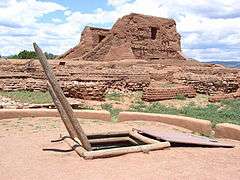Pecos National Historical Park
|
Pecos National Historical Park | |
|
Pecos Pueblo Mission Church | |
 | |
| Location | NM 63 SW of jct. with NM 50, San Miguel County, near Pecos, New Mexico |
|---|---|
| Coordinates | 35°33′00″N 105°41′22″W / 35.55000°N 105.68944°WCoordinates: 35°33′00″N 105°41′22″W / 35.55000°N 105.68944°W |
| Area | 6,671.4 acres (2,699.8 ha) |
| Built | 0800 |
| Visitation | 43,873 (2011)[1] |
| Website | Pecos National Historical Park |
| NRHP Reference # |
66000485 91000822[2] |
| Significant dates | |
| Added to NRHP | July 02, 1991 |
| Designated NHL | October 9, 1960 |
| Designated NMON | June 28, 1965 |
| Designated NHP | July 02, 1991 |
Pecos National Historical Park is a National Historical Park in the U.S. state of New Mexico. It is located about 17 miles (27 km) east of Santa Fe, New Mexico. The site was originally designated Pecos National Monument on June 28, 1965. In 1990 new lands were added to the park and the official designation was changed to Pecos National Historical Park. It includes the Pecos Pueblo, a National Historic Landmark.[3]
Pecos National Historical Park is composed of several noncontiguous units. The main unit of the park preserves the ruins of Pecos (Ciquique) Pueblo. The first Pecos pueblo was one of two dozen rock-and-mud villages built in the valley around AD 1100 in the prehistoric Pueblo II Era. Within 350 years the Pueblo IV Era Pecos village had grown to house more than 2,000 people in its five-storied complex.[4] The main unit also protects the remains of Mission Nuestra Señora de los Ángeles de Porciúncula de los Pecos, a Spanish mission near the pueblo built in the early 17th century. A 1.25-mile (2 km) self-guiding trail begins at the nearby visitor center and winds through the ruins of Pecos Pueblo and the mission church. The Pecos Pueblo (Ciquique) was declared a National Historic Landmark on October 9, 1960.[3][5]
In 1960, the National Park Service's statement of significance read:
This sizeable Pueblo community on the edge of the Plains was occupied for over 400 years. It was important in the history of the Spanish arrival in New Mexico, and the Spanish built and occupied a mission at the site for about 200 of those years. The site was abandoned in the 19th century by its last Pueblo residents.[3]
Pecos (Ciquique) was visited by expeditionaries with Francisco Vásquez de Coronado in 1540. The Spanish mission church, Mission Nuestra Señora de los Ángeles de Porciúncula de los Pecos, was built there in 1619. A traditional kiva was built in front of the church during the Pueblo Revolt in 1680 as a rejection of the Christian religion brought by Spanish colonists. However, when the Spanish returned in 1692, the Pecos community stayed on friendly terms with them. The site was abandoned in 1838, after the Pecos population suffered from marauding Comanches. The surviving remnant of the Pecos population moved to the Jemez Pueblo.[6]
Other park units protect the Glorieta Pass Battlefield, site of the American Civil War Battle of Glorieta Pass, as well as a stretch of wagon ruts along the old Santa Fe Trail. Both the Glorieta and Santa Fe units are currently closed to public use but can be visited on scheduled, ranger-guided tours.
Another part of the park is the Forked Lightning Ranch home designed by John Gaw Meem for Tex Austin and later occupied by Greer Garson.
The Pecos people enjoyed a rich culture with inventive architecture and beautiful crafts. They also possessed an elaborate religious life, evidenced by many ceremonial kivas. Farming was a main part of their diet and staple crops included the usual beans, corn, and squash. Their location, power and ability to supply goods made the Pecos a major trade center in the eastern part of the Puebloan territory.

See also
References
- ↑ "National Park Service Visitor Use Statistics". National Park Service. Retrieved October 6, 2012.
- ↑ National Park Service (2009-03-13). "National Register Information System". National Register of Historic Places. National Park Service.
- 1 2 3 "Pecos Pueblo". National Historic Landmark summary listing. National Park Service. Retrieved 2008-06-26.
- ↑ "People of the Pecos". U.S. Department of the Interior, National Park Service. February 6, 2011. Retrieved 2011-10-13.
- ↑ "National Register of Historic Places Inventory-Nomination" (pdf). National Park Service. May 15, 1958. Retrieved 2009-08-13.
"Accompanying 3 photos, exterior and interior, from 1946" (pdf). National Park Service. Retrieved 2009-08-13. - ↑ Dean R. Snow (2010). Archeology of Native North America. Prentice Hall.
External links
| Wikimedia Commons has media related to Pecos National Historical Park. |
| Wikiquote has quotations related to: Pecos Pueblo Land Grant |
- National Park Service: Pecos National Historical Park
- Pecos Conference
- American Southwest, a National Park Service Discover Our Shared Heritage Travel Itinerary
- Pecos Pueblo animation

